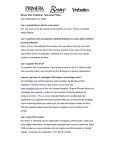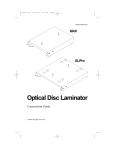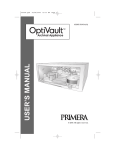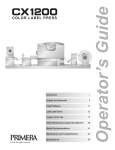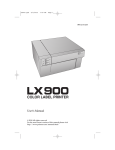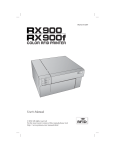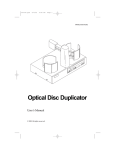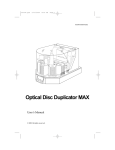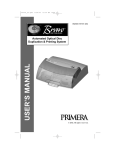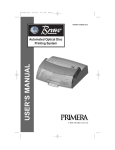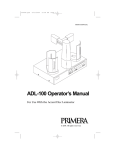Download Accent II Disc Laminator
Transcript
510885.qxd 7/18/2005 7:46 AM Page i 071805-510885-(05) TM DISC PUBLISHER USER’S MANUAL CD/DVDOptical Optical Automated Disc Disc Laminator Duplication & Printing System © 2005 All rights reserved. 510885.qxd 7/18/2005 7:46 AM Page ii Notices: The information in this document is subject to change without notice. NO WARRANTY OF ANY KIND IS MADE WITH REGARD TO THIS MATERIAL, INCLUDING, BUT NOT LIMITED TO, THE IMPLIED WARRANTIES OF MERCHANTABILITY AND FITNESS FOR A PARTICULAR PURPOSE. No liability is assumed for errors contained herein or for incidental or consequential damages in connection with the furnishing, performance, or use of this material. This document contains proprietary information, which is protected by copyright. All rights are reserved. No part of this document may be photocopied, reproduced, or translated into another language without prior written consent. Trademark Acknowledgments: Windows is a registered trademark of Microsoft Corporation. All other trademarks are the property of their respective owners. Printing History Edition 1.5, #510885, © Copyright 2005, All rights reserved. FCC Compliance Statement: This device complies with part 15 of the FCC rules. Operation is subject to the following two conditions: (1) this device may not cause harmful interference, and (2) this device must accept any interference received, including interference that may cause undesired operation. For Users in the United States: This equipment has been tested and found to comply with the limits for a Class B digital device, pursuant to Part 15 of the FCC Rules. These limits are designed to provide reasonable protection against harmful interference in a residential installation. This equipment generates, uses, and can radiate radio frequency energy and, if not installed and used in accordance with the instructions, may cause harmful interference to radio communications. However, there is no guarantee that interference will not occur in a particular installation. If this equipment does cause harmful interference to radio or television reception, which can be determined by turning the equipment off and on, the user is encouraged to try to correct the interference by one or more of the following measures: • Re-orient or relocate the receiving antenna. • Increase the separation between the equipment and receiver. • Connect the equipment into an outlet on a circuit different from that to which the receiver is connected. • Consult the dealer or an experienced radio/TV technician for help. Use of a shielded cable is required to comply with the Class B limits of Part 15 of the FCC Rules. You are cautioned that any changes or modifications not expressly approved in this manual could void your authority to operate and/or obtain warranty service for this equipment. For Users in Canada: This digital apparatus does not exceed the Class B limits for radio noise for digital apparatus set out on the Radio Interference Regulations of the Canadian Department of Communications. Le present appareil numerique n'emet pas de bruits radioelectriques depassant les limites applicables aux appareils numeriques de la class B prescrites dans le Reglement sur le brouillage radioelectrique edicte par le ministere des Communications du Canada. CAUTION! TO PREVENT FIRE OR SHOCK HAZARD, DO NOT EXPOSE THE UNIT TO RAIN OR MOISTURE. TO REDUCE THE RISK OF ELECTRIC SHOCK, DO NOT REMOVE EXTERIOR PANELS. NO USERSERVICEABLE PARTS INSIDE. REFER SERVICING TO QUALIFIED SERVICE PERSONNEL. OPERATE THE UNIT WITH ONLY THE PROPER ELECTRICAL SPECIFICATIONS AS LABELED ON THE LAMINATOR. ii 510885.qxd 2/16/2005 11:08 AM Page iii INDEX Table of Contents Section 1: Getting Started..............................................................................................1 A. Choosing a Good Location...............................................................................1 B. Unpacking and Inspection ...............................................................................1 C. Identifying the Parts..........................................................................................2 D. Applying the Power ..........................................................................................4 Section 2: Lamination Film and Optical Media........................................................5 A. About Lamination Film and Media ................................................................5 B. Installing Lamination Ribbons .......................................................................5 C. Laminating Discs in Stand-Alone Operation ................................................7 Section 3: Interpreting the Laminator’s Status LEDs .............................................9 A. Power LED..........................................................................................................9 B. Ready LED..........................................................................................................9 Section 4: Maintenance and Troubleshooting.........................................................10 A. Cleaning the Outer Case ................................................................................10 B. Cleaning the Inside of Your Laminator........................................................10 C. Troubleshooting ...............................................................................................11 D. Adjusting the Tray Speed ...............................................................................12 E. Technical Support ............................................................................................13 Section 5: Technical Specifications............................................................................14 Index ............................................................................................................................15 iii 510119pdf.qxd 5/29/2002 11:14 AM Page iv Interactive Feature in this PDF Document There are interactive features that will allow you to jump to different locations within the document. Each listing in the Table of Contents is interactive. Place the cursor on either the words or the page number. A small hand with a pointing finger icon appears. Click on the line with the icon and the document will jump to that page. If you want to return to the Table of Contents, move the icon to the top of the page and click on the arrow marked TOC. Navigating through the Index is similar. Place the icon on one of the listings or page numbers, click on it, and it will move to that page. The text relating to the Index listing will appear in red. Returning to the Index can be done by clicking on the arrow marked Index. iv 510885.qxd 2/16/2005 11:08 AM Page 1 TOC INDEX Section 1: Getting Started THANK YOU… …for purchasing the Disc Laminator. This Laminator is the perfect tool for creating water-resistant, scratchproof, smudgeproof discs quickly and easily. The Disc Laminator even lets you apply secure, holographic images directly onto the surface of your discs. Operation is simple, quality is high, and printed images take on a professional, screen-printed appearance. To begin using the Laminator, please read this manual carefully. This User's Manual is your complete step-by-step guide to quickly and easily setting up and laminating with your new Disc Laminator! A. CHOOSING A GOOD LOCATION • Place the Laminator in a location with adequate air circulation to prevent excessive internal heat build-up. • Do not place the Laminator near heat sources such as radiators or air ducts, or in a place subject to direct sunlight, excessive dust, mechanical vibration or shock. • Do not set items on top of the laminator. This could affect the quality of the transfer. • Allow for adequate clearance in front of the printer to accommodate the length of the unit with its CD Tray open. B. UNPACKING AND INSPECTION While unpacking your Laminator, inspect the carton to ensure that no damage has occurred during shipping. Make sure that all supplied accessories are included with your unit. The following items should be included: • Disc Laminator • Power Adapter and Power Cord • Warranty Statement and Registration Card • Starter Roll of Lamination Film • Quick Start Guide and Other Printed Information Save the carton and packing materials. They will come in handy later if you ever need to transport the Laminator. Getting Started 1 510885.qxd 2/16/2005 11:08 AM Page 2 INDEX TOC C. IDENTIFYING THE PARTS This illustration shows the Laminator and its control panel. Temperature Control Lever Cover Control Panel Disc Tray Hub Status LEDs Laminate Button Cover Release Button Disc Tray The Control Panel contains the Status LEDs, Laminate Button and Heat Setting. The Status LEDs consist of the Power LED and the Ready LED. The Power LED indicates that power is on. The Ready LED will flash to indicate the Laminator is heating or cooling. The Ready LED will show solid if the Laminator has reached proper operating temperature. The Temperature Control Lever lever allows the user to set the heat level. This level may vary depending on the type of disc being laminated. The Laminate Button is a multi-function button that will open and close the disc tray and will laminate the disc. The following chart describes this button's functions in greater detail. 2 Getting Started 510885.qxd 2/16/2005 11:08 AM Page 3 INDEX TOC Top Cover is: Tray is: Closed In, without disc Closed Out, without disc Closed Out, with disc Open Out OR In with Heat Roller ON In, with Heater OFF Out, with Heater OFF Open Open Function: Move Tray OUT Heats Laminator Heat Roller to operating temperature Will laminate if Heat Roller is at operating temperature Turns Heat Roller OFF Moves Disc Tray OUT Moves Disc Tray IN The Disc Tray contains a Disc Hub Spacer with two settings to allow you to choose whether or not to laminate the center hub of the disc. The Access Cover opens to provide access to the Overlaminate Film. This illustration shows the input ports found on the rear panel of the Laminator. If you are using the Laminator with an automated duplicator, the USB port will be used to allow the computer to control the Disc Tray. Power Switch Power Port USB Interface Port Auxiliary Port The Power Switch turns the Laminator's power on and starts the warm-up process. The USB Interface is only used when connecting the Laminator to a Duplicator when using Record, Print and Lamination mode. The Auxiliary Interface is only used when connecting the Laminator in place of a printer on a Duplicator when using Stand-Alone Lamination Mode. Getting Started 3 510885.qxd 2/16/2005 11:08 AM Page 4 TOC INDEX D. APPLYING THE POWER 1. Locate the power cord supplied with your Laminator. 2. Place one end of the power cord into the power port located on the rear panel of the Laminator. 3. Plug the power cord into an available outlet. Avoid plugging your Laminator into a battery backup or uninterruptible power supply. 4 Getting Started 510885.qxd 2/16/2005 11:08 AM Page 5 INDEX TOC Section 2: Lamination Film and Optical Media A. ABOUT LAMINATION FILM AND OPTICAL MEDIA Lamination Film for your Optical Disc Laminator is available in both a clear and holographic finish. The Holographic Overlaminate is used as a security feature making your discs easily identifiable as authentic. Holographic Overlaminate is also available with your own design when purchased in quantity. Please contact your dealer for details. Most inkjet printable discs will work well with some adjusting for heat. Because it is impossible to test all types of media, it is highly recommended you purchase a small amount for testing before committing to a large, bulk purchase of media. If you are having trouble with lamination quality, consider purchasing Accent Certified Media Kits. Kits contain CDs or DVDs that are specifically tested and certified for use with the Accent. These discs are the best possible combination of burnable surface, printable surface and lamination surface. For more information, visit our web store at www.primerastore.com. B. INSTALLING LAMINATION RIBBONS 1. Press the Access Cover Button to open the Access Cover. Access Cover Button Lamination Film and Optical Media 5 510885.qxd 2/16/2005 11:08 AM Page 6 INDEX TOC 2. Remove the Overlaminate Film and Take-Up Core from its packaging. The film comes pre-rolled on a core with a separate Take-Up Core included in the package. Supply Take-Up 1 3. Place the Take-Up Core in the front of the Laminator between the black plastic Ribbon Drive Hubs as shown. The left-side Hub is spring loaded. The Right side Hub has tabs that will engage and lock in place with the notches in the right side of the Take-Up Core. 4. Insert the Overlaminate Film in the rear set of hubs inside the Laminator as shown, keeping in mind that the Laminate will feed from over the top of the roll and the notches in the core will need to face the right-side of the laminator to lock in place with the ribbon drive hub. 5. The white portion of the leading edge of Overlaminate film has an adhesive coating. Pull it forward as shown, attaching it to the front Take-Up core. Turn the Take-Up Core towards the front of the laminator over the top to ensure the Overlaminate film is securely attached. When properly loaded the film will feed from over the top of the supply roll in back and will travel over the top of the Take-Up Core in front. 2 6 Lamination Film and Optical Media 3 510885.qxd 7/18/2005 7:46 AM Page 7 INDEX TOC C. LAMINATING DISCS IN STAND-ALONE OPERATION Now that you have successfully loaded the Lamination Film, you are ready to laminate your discs. A. Turn the Laminator Power Switch to the ON position. Press the Laminate Button. The Disc Tray will automatically eject from the Laminator. Press Laminate again to begin heating the Thermal Roller to operating temperature. Move the Temperature Control Lever to the desired setting. (The middle setting is recommended initially). The Ready LED should flash intermittently while the roller is heating. The process should take about 8-15 minutes. B. Once the READY LED is on and steady, the Laminator is at heat and ready to laminate your discs. You may need to make adjustments to the Laminator heat settings to ensure high quality output. Start with a test lamination to see if any adjustment will need to be made. This is done as follows: a. Place a disc on the Disc Tray. b. Press the Laminate Button. c. The disc will be drawn into the Laminator, laminated and the tray will be ejected. d. Examine the disc. If the lamination looks spotty, more heat is required. Increase the intensity. If the lamination shows scratch-like marks, the film is getting too hot and wrinkling. Reduce the heat setting. Wrinkle in film caused by excessive heat Uneven coverage due to inadequate heat Lamination Film and Optical Media 7 510885.qxd 2/16/2005 11:08 AM Page 8 TOC f. INDEX Also examine the laminate in the center hub of the disc. If the laminate is not adhering to the hub in the same manner as the rest of the disc, you may wish to avoid laminating the center hub. To do this, lift the Tray Disc Hub Spacer from the center of the Disc Tray and rotate it slightly clockwise. Place it back into the center of the Disc Tray making certain it seats properly in the tray. Disc Hub Spacer Disc Present Sensor With the Disc Tray Hub in this position, laminate will be transferred to the hub of the disc. Hub is even with disc surface Sensor With the Disc Tray Hub in this position, laminate will NOT be transferred to the hub of the disc. Hub is recessed to disc surface Sensor g. Repeat the test with another disc. When you are satisfied with the setting, you may want to make a note of them for future reference. You are now ready to laminate your discs. 8 Lamination Film and Optical Media 510885.qxd 2/16/2005 11:08 AM Page 9 INDEX TOC Section 3: Interpreting the Laminator's Status LEDs The LED Status Lights are located on the Control Panel. These LEDs can tell you a lot about what is happening with your Laminator at any given moment. To accurately interpret what is meant when these LEDs are on, off or flashing please Power refer to the following chart: Ready A. POWER LED Status Condition On Solid Flashing Rapidly Power is on, normal operation Ribbon Out Error Open the Front Cover and replace the ribbon as described in section 2-B. If you should see this error and the ribbon is NOT out, you may have encountered a media jam or internal error. Clear any torn or damage media, then press and hold the Laminate button for 5 seconds to reset the Laminator. Disc Out error, if using with a Primera duplicator, make sure discs are loaded, press Laminate button to continue operation. Flashing Slowly B. READY LED Status Condition On Solid Laminator's Heat Roller has achieved normal operating temperature. OFF Laminator's Heat Roller is not at operating temperature. ON Flashing OFF (LED is flashing with longer intervals where LED is on) Laminator's Heat Roller is heating up to normal operating temperature. OFF Flashing ON (LED is flashing with longer intervals where LED is off) Laminator's Heat Roller is cooling down. Interpreting the Laminator’s Status LEDs 9 510885.qxd 2/16/2005 11:08 AM Page 10 TOC INDEX Section 4: Maintenance and Troubleshooting This Laminator is designed to operate for extended periods of time with very little attention. In fact, no regular maintenance is recommended other than cleaning the unit. NOTE: Do NOT attempt to oil or grease the Laminators Tray Drive or internal mechanisms. You will likely cause more harm than good! All moving parts are designed to run for the life of the Laminator with no additional lubrication. A. CLEANING THE OUTER CASE Use a clean, white rag with a small amount of water or isopropyl alcohol to clean the Laminator and its tray. Stronger cleaning solutions are NOT recommended because they may damage the paint and plastic materials from which the parts are manufactured. Always disconnect your Laminator power cord before cleaning. Resume operation only after the surfaces are completely dry. B. CLEANING THE INSIDE OF YOUR LAMINATOR As you use your Laminator, dust and other particles may accumulate inside the case. These particles are attracted to the Lamination Film or discs by static. Dust can contaminate the Lamination Film and discs causing spots or speckles to appear. Periodically, use the following procedure to remove dust and other contaminants: 1. For safety, make certain the Laminator has been allowed to cool with power off for a period of at least 30 minutes. 2. Open the Laminator's Top Cover. 3. Remove the Lamination Film from the Laminator. 4. Use a lint free cloth and a small amount of Isopropyl Alcohol to wipe out all visible areas inside the Laminator. Remove any debris that may be inside. Be extremely careful not to let any alcohol drip inside the Laminator! 10 Maintenance and Troubleshooting 510885.qxd 2/16/2005 11:08 AM Page 11 INDEX TOC 5. The Lamination Roller can be cleaned periodically to avoid buildup of residue or dust. 6. You may also want to use a small electronics vacuum to remove any particles from inside the case. 7. Clean the Ribbon Deflector. This is the metal piece located inside the top cover in front of the rubber Lamination Roller. This can accumulate debris that can leave fine vertical scratches in thee disc. Simply run a fingernail across the deflector to clear it of debris, then wipe it clean with isopropyl alcohol. C. TROUBLESHOOTING Problem Resolution Will not Laminate • Check Power to the Laminator • Make sure that the Ready LED is on and steady indicating the Laminator's Heat Roller has achieved normal operating Temperature • In PrimoDVD, click Robotics then Options. You should see a Laminate check box.· • If you do not see this option in the Robotic Options dialog box, install the software on the install disc provided with your Laminator Stand. There is an updater on this disc that will add this functional. The Overlaminate Film is not adhering properly to my discs; there are patchy areas where the film is not sticking to the disc label. • Increase the heat setting with the Heat Slide Bar on the Laminator's Control Panel. Slide the Heat Setting one or two hash marks toward the front of the Laminator to increase the heat setting. The Overlaminate Film appears to be wrinkling, with scratch-like marks appearing across the surface of the disc • Decrease the heat setting with the Heat Slide Bar on the Laminator's Control Panel. Slide the Heat Setting one or two hash marks toward the rear of the Laminator to decrease the heat setting. I do not see an option in PrimoDVD to laminate discs Maintenance and Troubleshooting 11 510885.qxd 7/19/2005 12:28 PM Page 12 INDEX TOC C. TROUBLESHOOTING (continued) Problem Resolution There is a disc jammed in my Laminator - the tray has stalled. • Most likely the disc is not seated properly in the tray. Clear the jam by opening the top cover, and removing the disc from the laminator. If the Overlaminate film has torn, it can be reattached to the supply roll. Once the jam has been cleared, close the cover and press the Laminate button; the job will continue. D. ADJUSTING THE TRAY SPEED Adjusting the tray speed is a handy trouble shooting step if your media is not laminating consistently. You can easily adjust the tray speed in one of two ways: Via the Temperature Slide Bar. 1. Power off the Laminator. Slide the temperature bar to the far left to set the tray speed to its slowest setting, to the far right for the fastest speed setting or somewhere in between. (There are six tray speed settings from 1 - 2 inches per second - Default is 1.5) Once you have the slide bar in the desired location, press the laminate button as you turn on the laminator. Via the Print Driver. 2. Go to Start - Control Panel - Printers and Faxes - Right Click on the Disc Laminator - Choose Printing Preferences. Click Properties next to Lamination Speed. Decrease or Increase the tray speed accordingly. (From 1 - 2 inches per second - Default is 1.5) You would have installed the Driver if you have purchased one of the Laminator stands for a Composer XL/Pro/Max duplicators. If you have not installed the driver you can download it here: www.primera.com/primera_printer_drivers.html Once you have downloaded the driver you will need to connect the laminator to the computer with a standard USB cable. A driver installation wizard will appear. Finish the wizard to install the driver. 12 Maintenance and Troubleshooting 510885.qxd 2/16/2005 11:08 AM Page 13 TOC INDEX E. TECHNICAL SUPPORT If you have difficulties in operating your Laminator, the procedures in this manual should, in most cases, solve the problem. If you still have difficulty, call Technical Support at the number listed on the insert in your Laminator suppy pack. Maintenance and Troubleshooting 13 510885.qxd 7/19/2005 12:28 PM Page 14 INDEX TOC Section 5: Technical Specifications Lamination Method: Heated mass-transfer roller Overlaminate Films: ClearCoat™ transparent film, 400 discs, available in two grades: economy and standard AuthentiCoat™ holographic film, 400 discs, available in: • Custom holographic design for company logos, graphics, wording, etc. • Lamination Speed: Standard spinning CD design with "Authorized" text 1.0" to 2.0" per second Accepted Disc Sizes and Types: 120mm CDs or DVDs Adapter for "Hockey Rink" CDs and 80mm mini-CDs is available from tech support. Interface: Stand-alone or USB 1.1 Dimensions: 14.34" L x 13.53" W x 7.39"D (364mmL x 344mmW x 188mmD) Weight: 25 lbs. (11.3 kg) Agency Listings: Safety: UL, UL-C, CE Emissions: FCC Class B Supply Voltage: 100-120 VAC @ 3 amps 220-240 VAC @ 1.5 amps Supply Frequency: 50/60 Hz Warranty: Laminator mechanical and electrical: one year depot parts and labor; optional extended warranty available Options: Stand for DuplicatorXL™ or DuplicatorPro™ Stand for ComposerMAX™ Supported Autoloaders: ComposerXL, ComposerPro, ComposerMAX and ADL-100 14 Technical Specifications 510885.qxd 7/19/2005 12:28 PM Page 15 TOC Index Cleaning . . . . . . . . . . . . . . . . . . . . . . . . . . . . . . . . . . . . . . . . . . . . . . . . . . . 10 Control Panel . . . . . . . . . . . . . . . . . . . . . . . . . . . . . . . . . . . . . . . . . . . 2, 9, 11 Disc Tray . . . . . . . . . . . . . . . . . . . . . . . . . . . . . . . . . . . . . . . . . . . . . .2, 3, 7, 8 Disc Hub Spacer . . . . . . . . . . . . . . . . . . . . . . . . . . . . . . . . . . . . . . . . . . . .3, 8 Heat Roller . . . . . . . . . . . . . . . . . . . . . . . . . . . . . . . . . . . . . . . . . . . . .3, 9, 11 Heating Up . . . . . . . . . . . . . . . . . . . . . . . . . . . . . . . . . . . . . . . . . . . . . . . . . .7 Holographic Overlaminate . . . . . . . . . . . . . . . . . . . . . . . . . . . . . . . . . . . . .5 Installing Overlaminate Film . . . . . . . . . . . . . . . . . . . . . . . . . . . . . . . . .5, 6 Laminate Button . . . . . . . . . . . . . . . . . . . . . . . . . . . . . . . . . . . . . . . . . .2, 7, 9 Overlaminate Film . . . . . . . . . . . . . . . . . . . . . . . . . . . . . . . . . . . .3, 6, 11, 13 Power LED . . . . . . . . . . . . . . . . . . . . . . . . . . . . . . . . . . . . . . . . . . . . . . . .2, 9 Ready LED . . . . . . . . . . . . . . . . . . . . . . . . . . . . . . . . . . . . . . . . . . . . . . . .2, 9 Index 15 510885.qxd 2/16/2005 11:08 AM Page 16 Printed in the United States of America P/N 510885




















